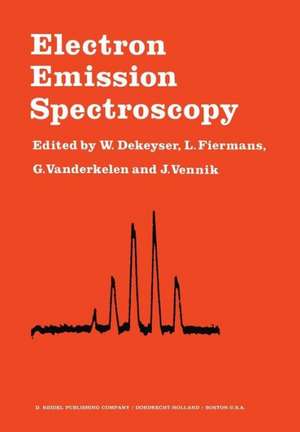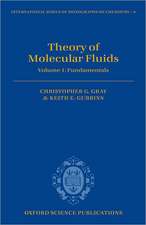Electron Emission Spectroscopy: Proceedings of the NATO Summer Institute Held at the University of Gent, August 28–September 7, 1972
Editat de W. Dekeyser, L. Fiermans, G. Vanderkelen, J. Venniken Limba Engleză Paperback – 5 noi 2011
Preț: 405.28 lei
Nou
Puncte Express: 608
Preț estimativ în valută:
77.57€ • 84.29$ • 65.20£
77.57€ • 84.29$ • 65.20£
Carte tipărită la comandă
Livrare economică 21 aprilie-05 mai
Preluare comenzi: 021 569.72.76
Specificații
ISBN-13: 9789401026321
ISBN-10: 9401026327
Pagini: 520
Ilustrații: 515 p.
Dimensiuni: 170 x 244 x 27 mm
Greutate: 0.82 kg
Ediția:Softcover reprint of the original 1st ed. 1973
Editura: SPRINGER NETHERLANDS
Colecția Springer
Locul publicării:Dordrecht, Netherlands
ISBN-10: 9401026327
Pagini: 520
Ilustrații: 515 p.
Dimensiuni: 170 x 244 x 27 mm
Greutate: 0.82 kg
Ediția:Softcover reprint of the original 1st ed. 1973
Editura: SPRINGER NETHERLANDS
Colecția Springer
Locul publicării:Dordrecht, Netherlands
Public țintă
ResearchCuprins
Electron Scattering by Solids.- 1. The Structure of Solid Surfaces.- 2. Elastic Electron-Solid Scattering: General Features.- 3. Elastic Low-Energy Electron Diffraction (ELEED).- 4. Surface Crystallography.- 5. Inelastic Low-Energy Electron Diffraction (ILEED).- 6. Synopsis.- Theoretical Aspects of X-Ray Photoelectron Spectroscopy.- 1. Introduction.- 2. Core Electron Binding Energies.- 3. Valence Electron Binding Energies.- 4. Multiplet Splittings and Multi-Electron Processes.- 5. Relative Intensities and Angular Distributions.- Crystal Field Theory and Calculation of the Inner Shell Vacancy Levels.- 1. Crystal Electric Potential.- 2. Multiplet Splitting in Crystalline Potential.- 3. Sternheimer Effect.- Molecular Photoelectron Spectroscopy.- 1. Historical Development.- 2. Instruments.- 3. Diatomic Molecules: Photoelectron Spectra and Potential Energy Diagrams.- 4. Intensities in Photoelectron Spectra.- 5. Polyatomic Molecules.- 6. Vibrational Structure of the Photoelectron Bands.- 7. Theoretical Calculation of Orbital Energies.- 8. Approximate Calculation of Orbital Energies.- 9. The Study of Large Molecules with Molecular Photoelectron Spectroscopy.- 10. The Dissociation of the Molecular Ion.- Auger Electron Spectroscopy for Surface Analysis.- 1. Introduction.- 2. Secondary Electron Energy Distributions.- 3. The Auger Process.- 4. Electron Excitation of Auger Spectra.- 5. Experimental Considerations.- 6. Auger Spectroscopy for Surface Analysis.- Bibliography compiled by D. T. Hawkins.- Chemical Aspects of ESCA.- 1. Introduction to ESCA, Applications to Chemical Analysis and Surface Studies.- 2. Application of ESCA to Studies of Structure and Bonding in Organic Molecules.- 3. Application of ESCA to Studies of Structure and Bonding in Inorganic Chemistry.- 4. Application of ESCA to Structure and Bonding in Polymers.










